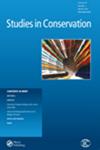Species Identification of Common Native Arctic Mammals in Inuit Fur Clothing Based on Hair Microscopy
IF 0.8
4区 化学
0 ARCHAEOLOGY
引用次数: 0
Abstract
ABSTRACT Correct material identification is considered essential when documenting museum objects. This study examines the morphology of mammal hair and records the geographical use of common species in Inuit fur clothing collected by the National Museum of Denmark (NMD) from c. 1830–1940 in the Bering Strait region, Alaska, Arctic Canada, and Greenland. Through hair microscopy, the purpose is to test whether original identifications are correct to assess the origin of unique Inuit garments. By means of transmitted light microscopy (TLM) of stained, 1 µm thick cross-sectioned hairs and undyed, longitudinally mounted hairs, the research reveals that specific morphological structures are characteristic of the common native reindeer/caribou, musk ox, members of the seal family, domestic dog, wolf, Arctic fox, polar bear, and wolverine. Rarer animals (hare, lynx, otter, etc.) are not part of this study because of limitations in the collection. Hairs from seal species are difficult to distinguish from one another. Hairs from dog and wolf are distinguishable but have relatively similar morphology. Therefore, to confirm identification, supplementary analyses are required. The hair microscopy technique was used on 49 garments in NMD’s collections, and the results were compared to the original macroscopic species identification. The study revealed that the latter method is often erroneous when it comes to dog/wolf and wolverine fur.基于毛发显微镜的因纽特人毛皮服装中常见北极土著哺乳动物的物种鉴定
摘要在记录博物馆藏品时,正确的材料标识是至关重要的。本研究考察了哺乳动物毛发的形态,并记录了丹麦国家博物馆(NMD)于1830-1940年在白令海峡地区、阿拉斯加、加拿大北极和格陵兰收集的因纽特人毛皮服中常见物种的地理用途。通过毛发显微镜,目的是测试原始标识是否正确,以评估独特因纽特人服装的起源。通过染色的1µm厚横截面毛发和未染色的纵向毛发的透射光显微镜(TLM),研究表明,特定的形态结构是常见的本地驯鹿/驯鹿、麝香牛、海豹科成员、家养狗、狼、北极狐、北极熊和狼獾的特征。稀有动物(野兔、山猫、水獭等)不属于本研究的一部分,因为采集的数量有限。海豹的毛发很难区分。狗和狼的毛是可以区分的,但形态相对相似。因此,为了确认身份,需要进行补充分析。用毛发显微镜技术对NMD收藏的49件服装进行了研究,并将结果与最初的宏观物种鉴定结果进行了比较。研究表明,后一种方法在涉及狗/狼和狼獾毛皮时往往是错误的。
本文章由计算机程序翻译,如有差异,请以英文原文为准。
求助全文
约1分钟内获得全文
求助全文
来源期刊

Studies in Conservation
化学-分析化学
CiteScore
1.80
自引率
12.50%
发文量
73
审稿时长
>12 weeks
期刊介绍:
Studies in Conservation is the premier international peer-reviewed journal for the conservation of historic and artistic works. The intended readership includes the conservation professional in the broadest sense of the term: practising conservators of all types of object, conservation, heritage and museum scientists, collection or conservation managers, teachers and students of conservation, and academic researchers in the subject areas of arts, archaeology, the built heritage, materials history, art technological research and material culture.
Studies in Conservation publishes original work on a range of subjects including, but not limited to, examination methods for works of art, new research in the analysis of artistic materials, mechanisms of deterioration, advances in conservation practice, novel methods of treatment, conservation issues in display and storage, preventive conservation, issues of collection care, conservation history and ethics, and the history of materials and technological processes. Scientific content is not necessary, and the editors encourage the submission of practical articles, review papers, position papers on best practice and the philosophy and ethics of collecting and preservation, to help maintain the traditional balance of the journal. Whatever the subject matter, accounts of routine procedures are not accepted, except where these lead to results that are sufficiently novel and/or significant to be of general interest.
 求助内容:
求助内容: 应助结果提醒方式:
应助结果提醒方式:


